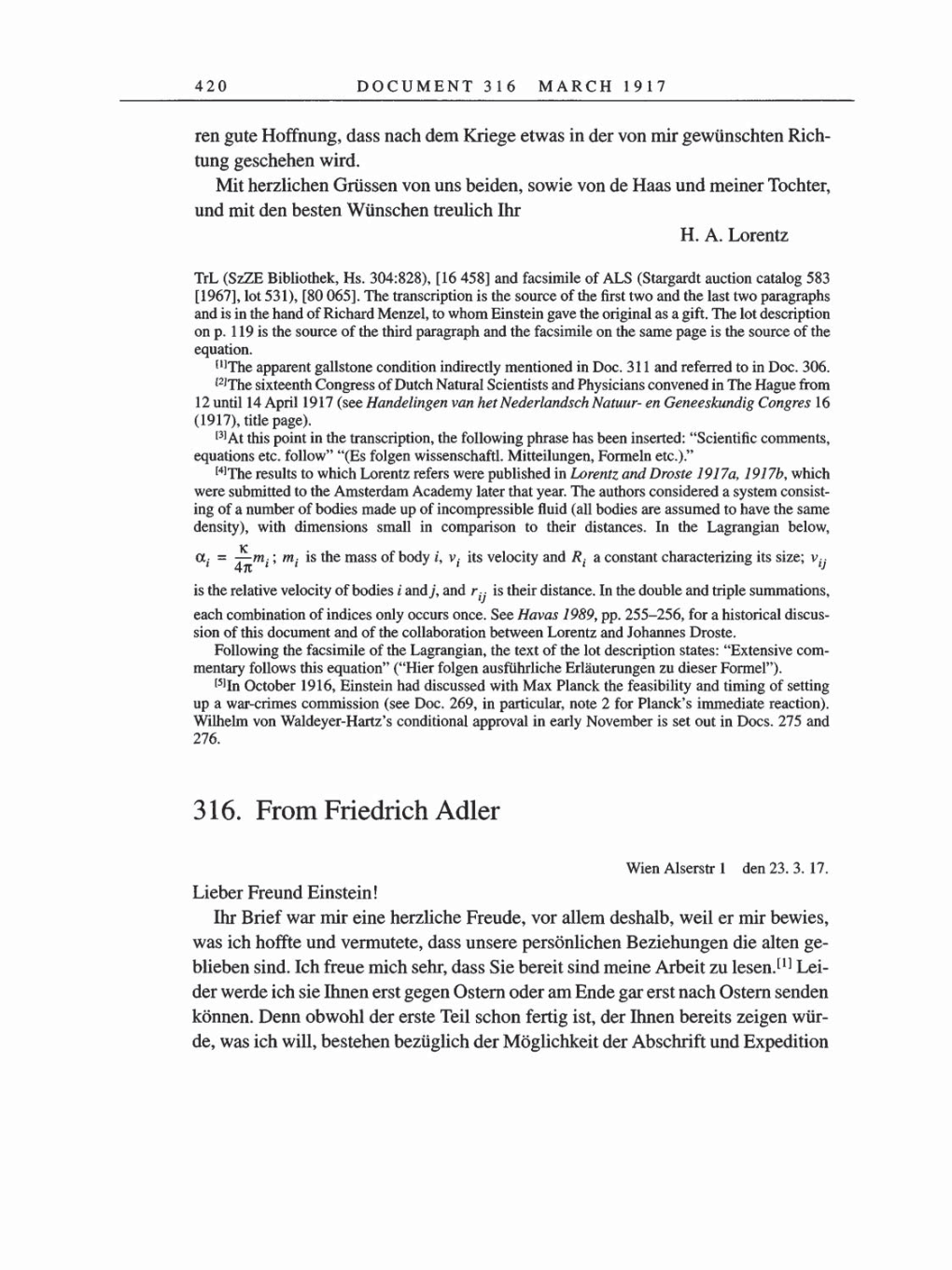420 DOCUMENT 316 MARCH 1917
ren gute Hoffnung,
dass nach dem
Kriege
etwas in der
von
mir
gewünschten
Rich-
tung geschehen
wird.
Mit herzlichen Grüssen
von
uns
beiden,
sowie
von
de Haas
und meiner
Tochter,
und mit den besten Wünschen treulich
Ihr
H. A. Lorentz
TrL
(SzZE
Bibliothek,
Hs.
304:828),
[16
458]
and facsimile
of
ALS
(Stargardt
auction
catalog
583
[1967],
lot
531), [80 065].
The
transcription
is the
source
of
the first
two
and
the
last two
paragraphs
and is in the hand
of
Richard
Menzel,
to whom
Einstein
gave
the
original as a gift.
The lot
description
on p.
119
is the
source
of
the third
paragraph
and
the
facsimile
on
the
same
page is
the
source
of
the
equation.
[1]The
apparent gallstone
condition
indirectly
mentioned
in
Doc.
311 and
referred
to in Doc.
306.
[2]The
sixteenth Congress
of
Dutch Natural Scientists and
Physicians
convened in The
Hague
from
12 until
14
April
1917
(see Handelingen
van
het
Nederlandsch Natuur-
en Geneeskundig
Congres 16
(1917),
title
page).
[3]At
this
point
in
the
transcription,
the
following phrase
has been inserted: “Scientific
comments,
equations
etc. follow”
“(Es
folgen
wissenschaftl.
Mitteilungen,
Formeln
etc.).”
[4]The
results
to
which Lorentz refers
were
published
in
Lorentz
and
Droste
1917a, 1917b,
which
were
submitted
to
the
Amsterdam
Academy
later
that
year.
The authors
considered
a system
consist-
ing
of
a
number
of
bodies made
up
of
incompressible
fluid
(all
bodies
are
assumed to have the
same
density),
with
dimensions
small in
comparison
to
their
distances. In the
Lagrangian
below,
K
ai
=
k/4nmi;
mi
is
the
mass
of
body i,
vi
its
velocity
and
Ri
a
constant
characterizing
its
size;
vij
is the relative
velocity
of
bodies
i
and
j,
and
rij
is
their
distance. In the double and
triple
summations,
each combination
of
indices
only occurs
once.
See
Havas
1989,
pp.
255-256,
for
a
historical discus-
sion
of
this
document
and
of
the collaboration
between
Lorentz and Johannes Droste.
Following
the
facsimile of
the
Lagrangian,
the text
of
the lot
description
states: “Extensive
com-
mentary
follows this
equation”
(“Hier folgen
ausführliche
Erläuterungen zu
dieser
Formel”).
[5]In
October
1916,
Einstein
had
discussed with
Max Planck the
feasibility
and
timing
of
setting
up a
war-crimes
commission
(see
Doc.
269,
in
particular,
note
2 for Planck’s immediate
reaction).
Wilhelm
von Waldeyer-Hartz’s
conditional
approval
in
early
November is
set
out in Docs. 275 and
276.
316.
From Friedrich
Adler
Wien
Alserstr
1
den 23.
3. 17.
Lieber Freund Einstein!
Ihr
Brief
war
mir
eine herzliche
Freude, vor
allem
deshalb,
weil
er
mir
bewies,
was
ich hoffte
und
vermutete,
dass
unsere
persönlichen
Beziehungen
die alten
ge-
blieben sind. Ich freue mich
sehr, dass Sie
bereit
sind
meine Arbeit
zu
lesen.[1]
Lei-
der werde ich sie
Ihnen
erst
gegen
Ostern
oder
am
Ende
gar
erst
nach
Ostern senden
können. Denn obwohl der erste Teil
schon
fertig
ist,
der
Ihnen
bereits
zeigen
wür-
de,
was
ich
will,
bestehen
bezüglich
der
Möglichkeit
der
Abschrift und
Expedition
